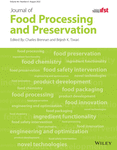Variation in amino acid composition of rice (Oryza sativa L.) as affected by the cooking technique
Abstract
Cooking accounted for significant (p <0 .01) loss in free and total amino acids (AAs) in rice. Fully milled raw rice reported relatively the lowest loss in total AAs (TAAs) over majority of the cooking techniques. Cooking rice with draining the excess water, cooking after discarding the soaked water, and cooking with higher water to rice ratios accounted for higher losses in AAs in all rice types. Cooking with rice cooker retained relatively more free AAs in rice. TAAs in raw rice types were not influenced by the cooking appliance, while gas cooker accounted for significantly higher losses in TAAs in parboiled rice. Cooking rice with draining and after discarding the soaked water caused higher losses in nutritional gamma amino butyric acid (GABA). Change in AAs in different rice types significantly varied with the cooking technique used. Hence, the importance of cooking practices in ensuring the optimum AA retention in rice is highlighted.
Novelty impact statement
Depending on the cooking technique and the variety being cooked, the influence imparted on the nutritional value of cooked rice is varied. Although the physical and compositional changes involved in starch component in rice subsequent to cooking have been a choice of popular interest, relatively less attention has been drawn towards the changes encountered in the amino acid composition in the cooked rice grain that constitutes the proteins, which is the second most abundant nutrient that comprises rice next to carbohydrates. Depending on the regional and cultural consumption patterns, preparation techniques of rice differ in numerous ways. Hence, how the amino acid compositional changes occur with respect to the variety and the cooking technique was investigated.
CONFLICT OF INTEREST
The authors have declared no conflicts of interest for this article.
Open Research
DATA AVAILABILITY STATEMENT
The data that support the findings of this study are available on request from the corresponding author. The data are not publicly available due to privacy or ethical restrictions.




